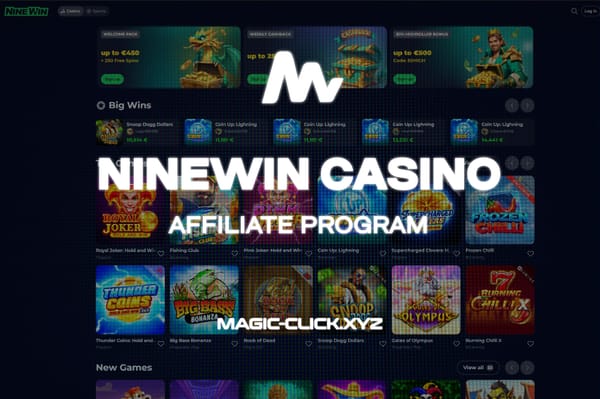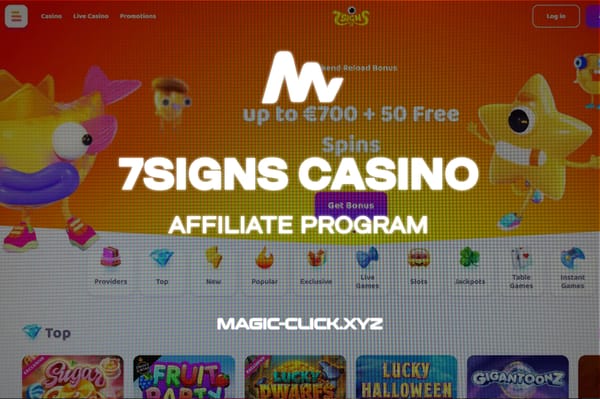What is traffic arbitrage? For beginners in 2024
Traffic arbitrage is an online profession where an arbitrageur (often by setting up targeted ads) buys traffic at a low price on one…
Traffic arbitrage is an online profession where an arbitrageur (often by setting up targeted ads) buys traffic at a low price on one platform and redirects it to another platform to make a profit. The arbitrageur earns money from the difference between the cost of the traffic and the revenue generated from ads or sales of products or services on the target platform. In their work, arbitrageurs operate like webmasters with websites, SMM marketers with social networks, and targetologists with ad and search systems, depending on their skills and specialization.

⠀ Magic Click Partners — Reliable CPA network with over 500 offers in ⠀⠀⠀⠀⠀⠀⠀⠀iGaming and Betting verticals from direct advertisers.

In this article, we will delve into what arbitrage is, where to get traffic, how much an arbitrageur earns, and how a beginner can become a top specialist.
What is Arbitrage and What Does an Arbitrageur Do?
Traffic arbitrage involves both buying and selling traffic to make a profit. Traffic refers to real users obtained through clicks on ads and subsequent actions such as purchases, registrations, downloads, and deposits. The goal in affiliate marketing is to attract users at the lowest possible cost and direct them to advertising offers to perform a desired action. The arbitrageur earns a profit from the difference between the cost of acquiring traffic and the revenue generated from its monetization.
Daily Tasks of an Arbitrageur
The typical day of an arbitrageur mainly involves setting up and optimizing ads, similar to a targetologist. This includes analyzing the audience, creating creatives, placing ads, analyzing performance metrics, and constantly communicating with advertisers.
Key Points About Traffic Arbitrage
- Entrepreneurial Role: An arbitrageur is not just a hired targetologist buying clicks but often an entrepreneur who invests their own money and takes risks. Payment is made post-factum after traffic quality and sales are verified. Initially, they invest their own or the team’s funds into promotion. There’s a risk of not targeting the right audience, failing to bring leads, and losing money.
- Constant Testing: An arbitrageur must constantly test ad combinations and creatives. One cannot create a single combination and use it for years. New platforms, ideas, and products need to be tested regularly to stay profitable because user interest and attention need to be continually captured and surprised with fresh creatives.
- Teamwork for Success: For outstanding results, an arbitrage team typically includes a creative specialist, a web developer, an analyst, and a manager. If the team is small, members might share these roles based on their skills. This structure allows for faster scaling and growth, leading to higher earnings.
By understanding these aspects, a beginner can navigate the complexities of traffic arbitrage and aim to become a successful specialist in this dynamic field.
Traffic Arbitrage Dictionary: Key Terms
- Offer: A promotional proposal where arbitrageurs are invited to promote a product or service. It can be packaged in videos, images, landing pages, pre-landing pages, or texts.
- Lead: A prospect or potential customer who is ready to make a purchase.
- Hold: The period during which the advertiser checks the quality of the traffic before releasing payment.
- Combo: A combination of actions and elements such as creatives, landing pages, and CTAs designed to drive users to convert on an offer.
- Affiliate Program or CPA Network: A platform where advertisers place offers, and arbitrageurs select them for promotion.
Payment Methods in Arbitrage
The key feature of traffic arbitrage is that an arbitrageur can set up a successful ad combination (creative) once and profit from the resulting traffic for an extended period. Payment is made only for quality traffic that meets age, geographic, and behavioral requirements, ensuring conversions on the advertiser’s offer.
Here’s how payments in arbitrage are calculated:
- Cost Per Click (CPC): Payment for each click on the ad link. The arbitrageur’s task is to create a highly appealing offer that attracts clicks.
- Cost Per Mille (CPM): Payment for every 1,000 views of an ad. The arbitrageur needs to choose the most effective channel and create engaging creatives.
- Cost Per Action (CPA): Payment is made only when a user completes a specific action, such as registering on a site or making a purchase. The arbitrageur must accurately target the audience and drive them to the desired action.
- Cost Per Lead (CPL): Payment for each lead that provides their contact information. This is commonly used in the service sector, where the deal is closed by a manager.
- Revenue Share: The arbitrageur receives a percentage of the revenue generated from the user. For example, if an arbitrageur drives traffic to an affiliate program, they earn a commission on sales.
The earnings of an arbitrageur depend directly on the amount invested and the quality of the traffic.
Specialists can earn from $700 to $3,000, with top earners making up to $50,000. Those with several years of experience or working with international advertisers typically earn between $1,000 and $3,000, depending on their traffic investments and funnel effectiveness.
Types of Verticals: White, Gray, Black
In traffic arbitrage, there are three types of offers: white, gray, and black. Gray and black usually cover the same niches but differ in the degree of prohibition by the advertiser, affiliate program, or advertising platform. Gray and black verticals are harder to promote due to constant moderation blocks, resulting in rejected ads or landing pages and potential account bans.
White Offers White offers in arbitrage do not violate laws or platform rules. All actions are legal and permitted. The arbitrageur attracts traffic through legitimate methods, uses effective ad campaigns, and strives to honestly increase conversion rates and profits.
Examples of white offers:
- Product Offers: Affordable mass products, often from China. Promotion involves creating single-page websites, adding photos and descriptions, and placing links in banner, contextual, or teaser ads. This is a straightforward entry point into arbitrage as it requires no advanced funnel creation skills.
- E-commerce: Promoting various products. This is easy to advertise since most users are accustomed to online shopping and readily order from unfamiliar sites.
- Info Products: Online educational products, such as courses or workshops. Promoting these is harder since the expert must be trusted, and the arbitrageur must find an interested audience. This requires thoughtful traffic funneling strategies.
- Subscription Services and Banking Loans: Automatically and regularly charged services and bank loans.
White offers have the advantages of a low entry barrier, easy understanding of basic arbitrage schemes, simple creative creation, high-paying verticals, and the possibility to work without a team. The disadvantages include high competition and lower payouts compared to other niches.
Gray Offers Unlike white verticals, gray offers involve less ethical or ambiguous methods for attracting traffic or promoting not entirely permitted products. The arbitrageur may use lower-quality traffic sources like spam sites or bots to increase clicks and earnings from traffic sales.
- Gambling: Advertising registrations for online casinos, emphasizing quick returns on investments and winning statistics.
- Betting: Sports betting and bookmakers, offering returns similar to gambling.
- Dating: Offers promoting sexual encounters, directing traffic to sites or apps like Tinder or Badoo.
- Nutra: “Magic” pills that promise skin improvement, potency enhancement, hair growth, or wrinkle removal.
- Adult: Advertising 18+ products, porn, and webcams, which may not always be legally permissible.
- Payday Loans (PDL): Promoting high-yield microloans and loans.
- Crypto Offers: Promoting investments in cryptocurrencies, forex, and binary options.
The main drawback of gray verticals is that the arbitrageur violates advertising platform rules, risking account bans. Moreover, advertisers may prohibit the use of low-quality traffic and withhold payments, leading to significant risks and negative consequences.
Black Offers Black arbitrage is an even more illegal traffic arbitrage model. The arbitrageur uses completely prohibited methods to attract traffic and earn profits.
- Malware: Using malicious software, viruses, or trojans to infect users’ computers and redirect them to ad pages.
- Stolen Data: Using stolen or illegally obtained user data to target ads.
Traffic Sources for Offers
The most popular traffic sources for arbitrageurs include Facebook targeting, Google contextual ads, SEO, and semi-free traffic from social networks (posts/publications/tags/spam), forums (comments/threads), messengers (channels/chats), blogs, and video hosting platforms (streams). Other frequently used traffic sources include:
- Search Engines: Offers launched through Google Ads or Yandex.Direct for users searching for specific products or services.
- Social Networks: Targeted ads on Facebook*, Instagram*, Twitter, TikTok, or VK aimed at audiences based on interests, demographics, and behavior patterns.
- Native Advertising: Partner posts or contextual ads attracting traffic through recommendations or automatically selected content.
- Mobile Advertising: Ads in mobile apps through in-app ad networks or mobile web targeting.
- Email Marketing: Sending promotional emails to a subscriber base gathered on the arbitrageur’s site or through affiliate programs.
- Teaser Networks: Native ad-like announcements with images and text, often promoting offers with catchy headlines and intriguing images.
- Video Advertising: Pre-roll ads on YouTube or TikTok.
Traffic arbitrage is a promising niche with a clear entry point through products and vast potential for scaling if conversions are high. Based on my experience, the quickest profit is often found in the product vertical with cool creatives and initial investments leading to quick leads and sales. Continual testing of new schemes and analyzing statistics is crucial for accurately targeting audiences and maintaining user attention.
By understanding and leveraging these concepts, a beginner can navigate the traffic arbitrage field and become a successful specialist.





